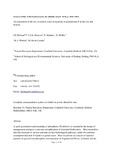JavaScript is disabled for your browser. Some features of this site may not work without it.
| dc.contributor.author | Holman, Ian P. | - |
| dc.contributor.author | Howden, N. J. K. | - |
| dc.contributor.author | Bellamy, Patricia H. | - |
| dc.contributor.author | Willby, N. | - |
| dc.contributor.author | Whelan, M. J. | - |
| dc.contributor.author | Rivas Casado, Monica | - |
| dc.date.accessioned | 2011-10-20T23:18:03Z | |
| dc.date.available | 2011-10-20T23:18:03Z | |
| dc.date.issued | 2010-03-15T00:00:00Z | - |
| dc.identifier.issn | 0048-9697 | - |
| dc.identifier.uri | http://dx.doi.org/10.1016/j.scitotenv.2009.11.026 | - |
| dc.identifier.uri | http://dspace.lib.cranfield.ac.uk/handle/1826/5038 | |
| dc.description.abstract | A good quantitative understanding of phosphorus (P) delivery is essential in the design of management strategies to prevent eutrophication of terrestrial freshwaters. Most research to date has focussed on surface and near-surface hydrological pathways, under the common assumption that little P leaches to groundwater. Here we present an analysis of national patterns of groundwater phosphate concentrations in England and Wales, Scotland, and the Republic of Ireland, which shows that many groundwater bodies have median P concentrations above ecologically significant thresholds for freshwaters. The potential risk to receptor ecosystems of high observed groundwater P concentrations will depend on (1) whether the observed groundwater P concentrations are above the natural background; (2) the influence of local hydrogeological settings (pathways) on the likelihood of significant P transfers to the receptor; (3) the sensitivity of the receptor to P; and, (4) the relative magnitude of P transfers from groundwater compared to other P sources. Our research suggests that, although there is often a high degree of uncertainty in many of these factors, groundwater has the potential to trigger and/or maintain eutrophication under certain scenarios: the assumption of groundwater contribution to river flows as a ubiquitous source of dilution for P-rich surface runoff must therefore be questioned. Given the regulatory importance of P concentrations in triggering ecological quality thresholds, there is an urgent need for detailed monitoring and research to characterise the extent and magnitude of different groundwater P sources, the likelihood for P transformation and/or storage along aquifer- hyporheic zone flow paths and to identify the subsequent risk to receptor ecosystems. (C) 2009 Elsevier B.V. All rights reserved. | en_UK |
| dc.language.iso | en_UK | - |
| dc.publisher | Elsevier Science B.V., Amsterdam. | en_UK |
| dc.subject | Leaching Eutrophication Baseflow Orthophosphate Phosphorus south-east england cow slurry beneath nitrate concentrations phosphate sorption sewage-treatment nutrient inputs phosphorus loss storage lagoon sand aquifer soil | en_UK |
| dc.title | An assessment of the risk to surface water ecosystems of groundwater P in the UK and Ireland | en_UK |
| dc.type | Article | - |
Files in this item
This item appears in the following Collection(s)
-
Staff publications (SAS) [907]
